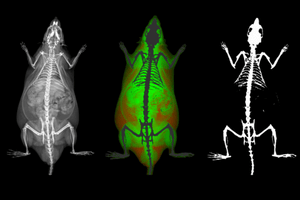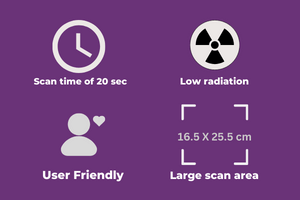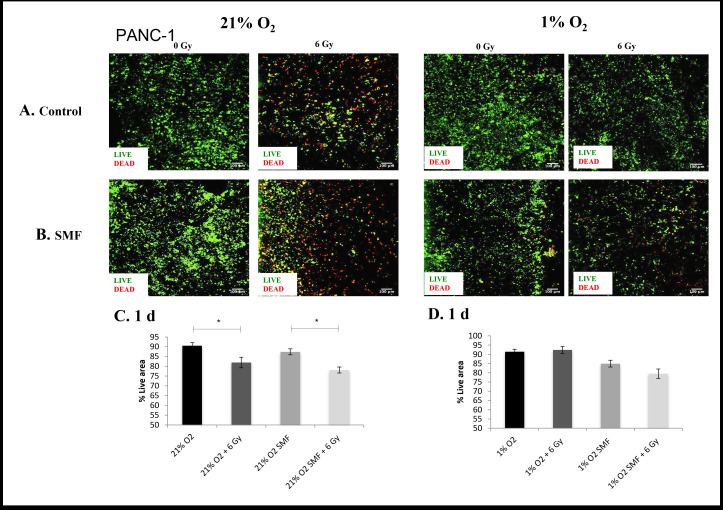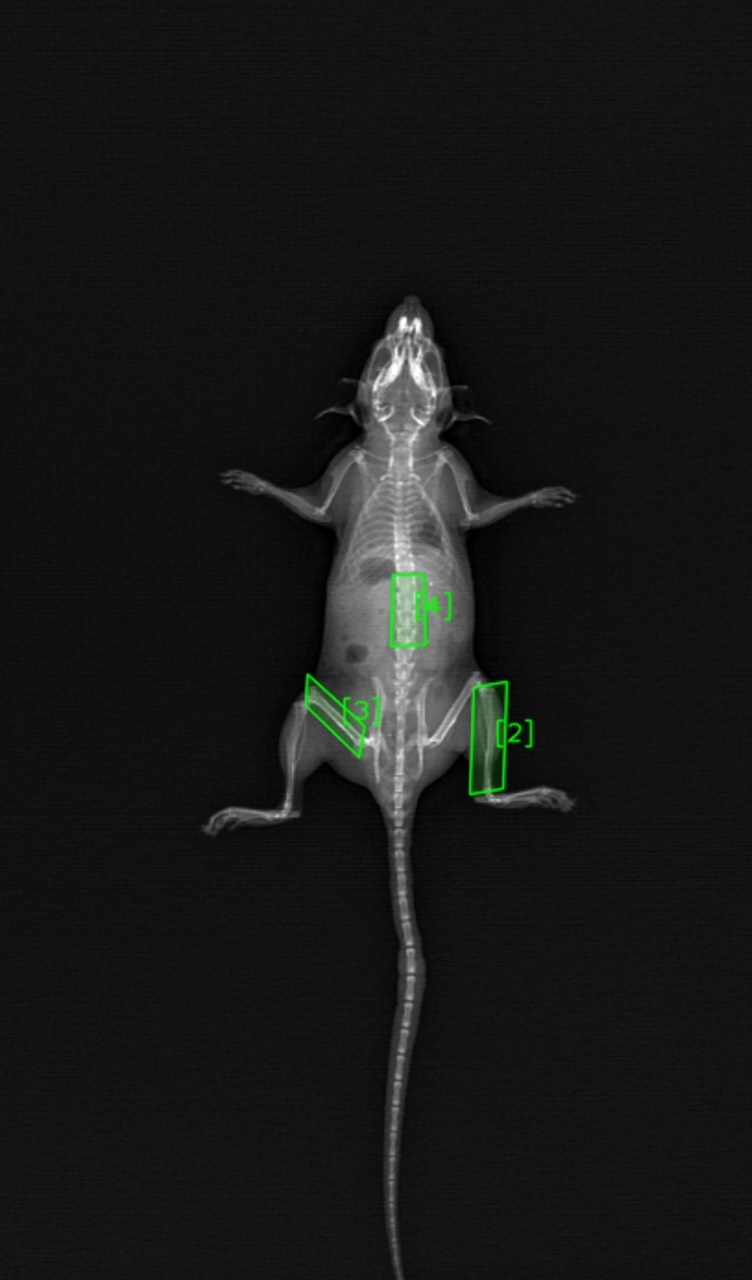iNSiGHT DXA
In Vivo Dual Energy X-Ray Absorptiometry (DXA/DEXA) For Preclinical Research

System Overview
The iNSiGHT DXA system is a state-of-the-art in vivo Dual Energy X-Ray Absorptiometry (DXA/DEXA) technology designed for preclinical research. It provides a comprehensive solution for evaluating a wide range of metabolic disorders, such as osteoporosis, arthritis, diabetes, obesity, and musculoskeletal pathologies, including bone regeneration and muscle wasting diseases.
This system is equipped with a fully shielded X-ray cabinet, making it suitable for small animal DXA applications, with a focus on mice, rats, and animals of similar size (up to 5kg). It provides fast and efficient body composition measurements. The system’s fast scan times of 25 seconds, combined with its low-dose radiation, make it ideal for longitudinal studies.
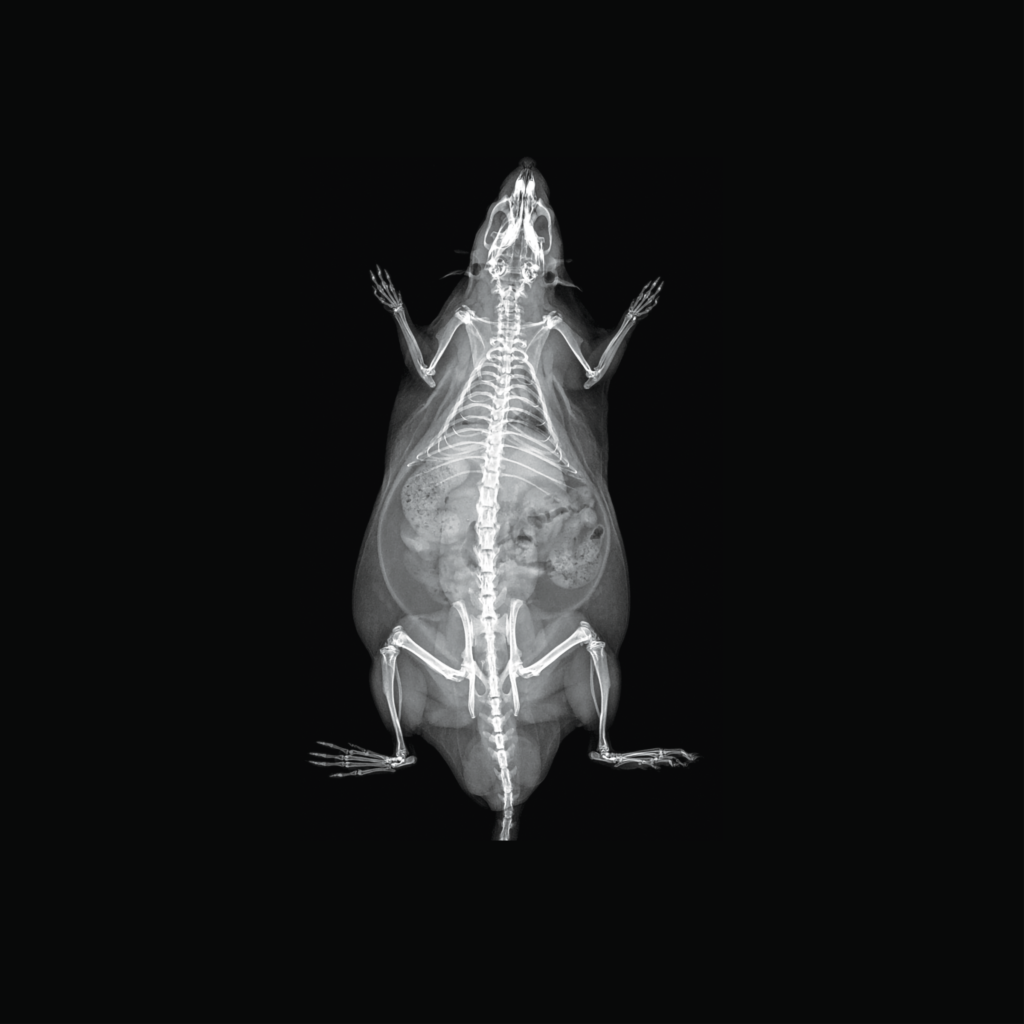
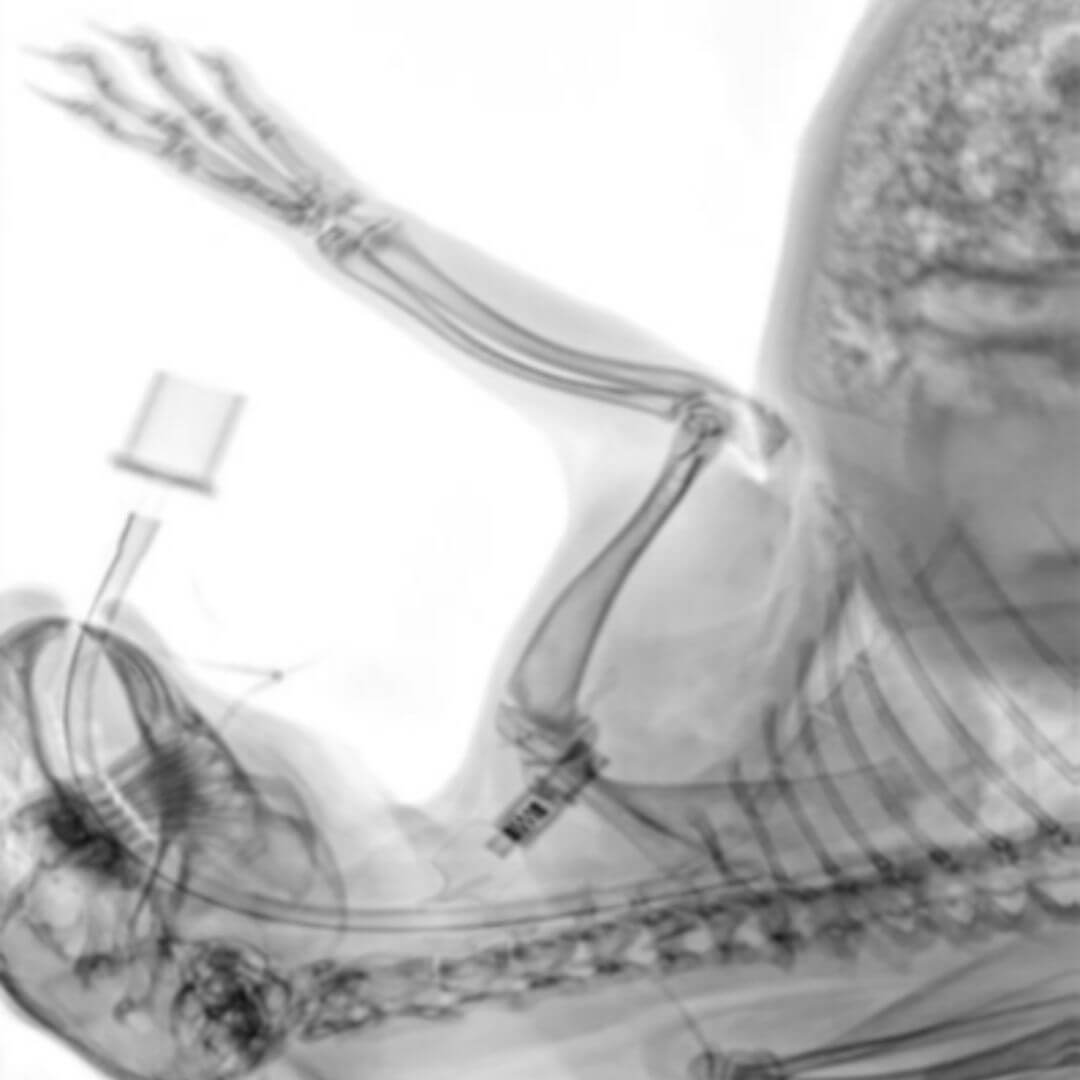
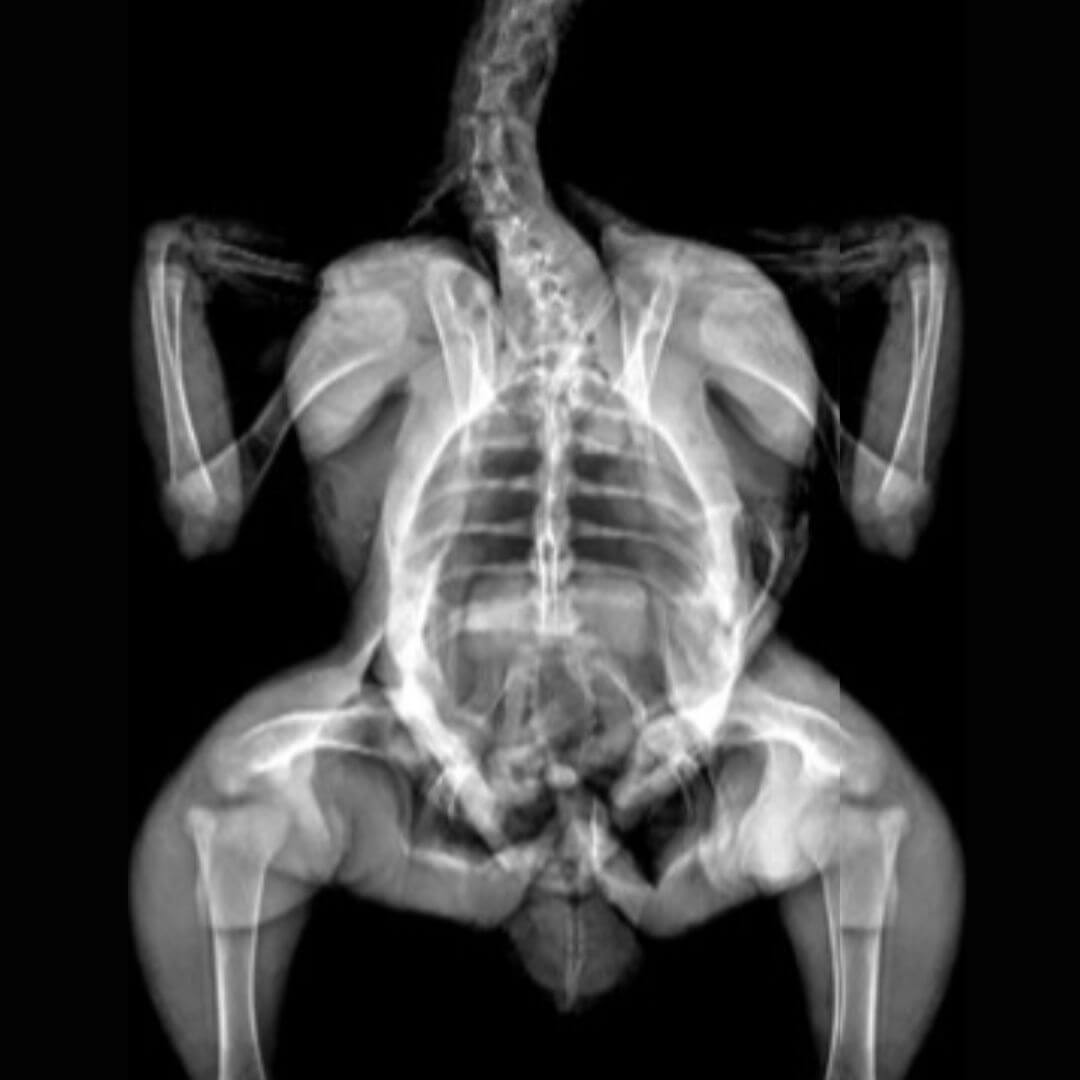
The iNSiGHT system uses dual energy x-rays to obtain highly accurate and reproducible body composition measurements. The system assigns each pixel to one of three compartments: fat mass, non-bone/lean mass, or bone mineral content, providing measurements such as bone mineral density, bone mineral content, bone area, tissue area, fat tissue as a percentage and weight, lean tissue as a percentage and weight, and total weight in grams.
This technology is non-invasive, non-destructive, and does not require any pre-treatment of the animal, contrast, or substrate injection. The iNSiGHT system also provides specific bone length measurements that can be drawn from the 2D x-ray image.
Features & Benefits
The iNSiGHT is a Dual Energy X-Ray Absorptiometry (DXA/DEXA) system designed specifically for in vivo preclinical research applications
Easy data acquisition
No preparation steps other anesthesia required. This can be done using the integrated anesthesia system, or with injectable anesthesia if desired.
Once ready the imaging subject is placed on stage and imaging can begin, using the easy-to-use acquisition software.
Large scan area
The iNSiGHT system allows for a variety of animal models and tissue samples to be imaged, from 10g ~ 5kg. (Scan Area: 16.5 x 25.5 cm)
This allows users to image not only mice and rats, but other species such as non-human primates, fish, rabbits, etc.
25 second scan time
The iNSiGHT has the fastest scan time on the market, allowing for high-throughput imaging.
Comprehensive set of images and parameters
In a single scan (25 seconds) the x-ray attenuated image, bone mineral density map and color map are generated.
A number of parameters are calculated from these images – either from the whole animal or for user defined regions of interest (ROI):
- Bone Mineral Content (BMC) (g/cm2)
- Bone Mineral Density (BMD) g)
- Bone area (cm2)
- Tissue area (cm2)
- Fat tissue (mass and percentage) (g & %)
- Lean tissue (mass and percentage) (g & %)
- Total mass (g)
Low-dose radiation
The iNSiGHT was designed to minimize the ionizing radiation (0.66 mGy) required to generate images and data. This minimization prevents any effect of the image acquisition on the subject, allowing for multiple imaging time points over the course of a longitudinal study.
Adjustable field of view and resolution
The iNSiGHT system has several levels of magnification, adjust the field of view (FOV) and resolution to suite your specific needs.
(100µm – up to 31µm in Digital Radiography Mode)
Models & Specifications

Add-ons
- Anesthesia Control
- Digital Radiography Mode (high-resolution images – up to 31 microns)
- Offline Analysis Software
iNSiGHT
DXA-
Scan Method : Cone Beam
-
Animal Size : Mice, rats, and animals of similar size (up to 5kg)
-
Image Area (maximum) : 16.5 x 25.5cm
-
Pixel Size : 100µm at 1.2X 31µm at 4X with DR Mode
-
Operating System : Windows 10, 64bit
-
Dimensions (WxDxH) : 66 x 61 x 113 cm
-
Power : 110/240VAC, 50/60Hz, 200VA
-
Operating Temp : 10 ~ 40oC
Applications
Metabolic Disorders
Metabolic disorders occur when the normal metabolic processes within the body are disrupted, either due to genetic abnormalities, or developed due to environmental conditions.
There is a very long list of metabolic disorders, but most common are diabetes, metabolic syndrome, obesity, etc. There are a large number of small animal models of these diseases which could benefit from DXA imaging to help elucidate the genetic, molecular, and biochemical pathways that are integral to these pathologies.
The iNSiGHT system can be used to assess the progression or regression of disease and body composition measurements in response to a therapeutic regime by measuring changes in fat and lean mass over time. The colorimetric image allows for the differentiation, by way of regions of interest, of visceral and subcutaneous fat, which may play a key role in further understanding these pathologies.
In this example the researchers were monitoring changes in body composition using a diabetic mouse model. They noted a reduction in fat mass, lean mass, and bone mineral content in the diabetic mouse model compared to the control.

Kishi K, Goto M, Tsuru Y, Hori M. Noninvasive monitoring of muscle atrophy and bone metabolic disorders using dual-energy X-ray absorptiometry in diabetic mice. Exp Anim. 2022 Sep 15. doi: 10.1538/expanim.22-0097. Epub ahead of print. PMID: 36104204
Drug safety and toxicology
Drug safety and toxicology studies are key to the progression of target compounds progressing to clinical trials. In addition to efficacy of the target compound on their intended pathology, it is also very important to study their safety and potential toxic effects, some of these effects may be seen by studying changes in either the bones or fat and lean tissues. Small animal studies are routinely used for drug safety and toxicology screening protocols prior to target compounds advancing to more advanced preclinical studies in non-human primates for example, or before moving to clinical trials.
The iNSiGHT system can be used to assess changes in body composition in response to the administration of a target compound at an effective dose. This can be done by looking for changes in bone mineral density and content, and/or by measuring changes in fat and lean mass over time.
In this example the researchers were studying the effect of polyphenol treatment on a rat model of ovariectomy.
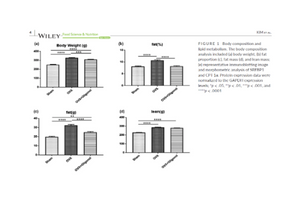
Kim, J. H., Lee, H., Kim, J. M., Lee, B.-J., Kim, I.-J., Pak, K., Jeon, Y. K., & Kim, K. (2022). Effect of oligonol, a lychee-derived polyphenol, on skeletal muscle in ovariectomized rats by regulating body composition, protein turnover, and mitochondrial quality signaling. Food Science & Nutrition, 10, 1184– 1194.
Musculoskeletal diseases
This is a large group of pathologies, which does include metabolic bone diseases as well as arthritis, both mentioned earlier, but further includes other disease effecting either the bones or muscles. Additional diseases include bone fractures and healing, bone and/or muscle regeneration, muscle wasting diseases. There are a large number of small animal models of these diseases which could benefit from DXA imaging to help elucidate the genetic, molecular, and biochemical pathways that are integral to these pathologies.
The iNSiGHT system can be used to assess the progression or regression of disease in response to a therapeutic regime by measuring changes in bone mineral density and content and/or by measuring changes in fat and lean mass over time.
In this example, low-dose lithium supplementation was examined and found to promote adipose tissue browning and sarco(endo)plasmic reticulum Ca2+ ATPase uncoupling in muscle.
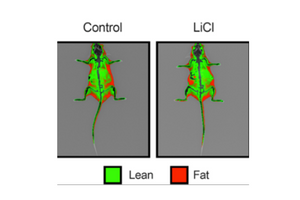
Geromella MS, Ryan CR, Braun JL, Finch MS, Maddalena LA, Bagshaw O, Hockey BL, Moradi F, Fenech RK, Ryoo J, Marko DM, Dhaliwal R, Sweezey-Munroe J, Hamstra SI, Gardner G, Silvera S, Vandenboom R, Roy BD, Stuart JA, MacPherson REK, Fajardo VA. Low-dose lithium supplementation promotes adipose tissue browning and sarco(endo)plasmic reticulum Ca2+ ATPase uncoupling in muscle. J Biol Chem. 2022 Nov;298(11):102568. doi: 10.1016/j.jbc.2022.102568. Epub 2022 Oct 7. PMID: 36209826; PMCID: PMC9664358.
Metabolic Bone Disease & Arthritis
Metabolic bone disease is a category of several diseases all causing some type of abnormality of deformity within the bone structure. Some examples include osteoporosis, rickets, osteomalacia, osteogenesis imperfecta etc. There are a large number of small animal models of these diseases which could benefit from DXA imaging to help elucidate the genetic, molecular, and biochemical pathways that are integral to these pathologies.
Arthritis is an inflammation of the joints, which can lead to swelling and pain within the affected area. It is not a single disease, but more informally refers to joint pain or joint disease. There are more than 100 types of arthritis, but most common are osteoarthritis and rheumatoid arthritis. There are a large number of small animal models of these diseases which could benefit from DXA imaging to help elucidate the genetic, molecular, and biochemical pathways that are integral to these pathologies.
The iNSiGHT system can be used to assess the progression or regression of disease in response to a therapeutic regime by measuring changes in bone mineral density and content in the effected joints. Often these changes are seen earlier in the disease progression, while therapies may still be effective, prior to being visible on a traditional x-ray image. Once changes are visible on an x-ray the disease is considered quite advanced and recovery or response to therapy is not likely.
In this example the iNSiGHT DXA system revealed higher cone mineral content (BMC) and bone mineral density (BMD) values in the whole body and lumbar vertebrae of C3H mice (mice susceptible to atherosclerosis).
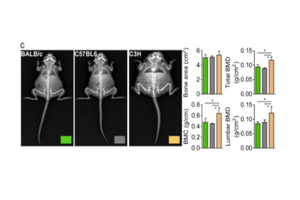
Kim MY, Lee K, Shin HI, Lee KJ, Jeong D. Metabolic activities affect femur and lumbar vertebrae remodeling, and anti-resorptive risedronate disturbs femoral cortical bone remodeling. Exp Mol Med. 2021 Jan;53(1):103-114. doi: 10.1038/s12276-020-00548-w. Epub 2021 Jan 12. PMID: 33436949; PMCID: PMC8080628
Hypoxia
Hypoxia exposure, in vivo, is thought to alter the metabolic state of the exposed animal; this may potentially effect glucose metabolism and energy expenditures. There are a large number of small animal models where hypoxia exposure is being studied, of importance are changes in body composition.
The iNSiGHT system can be used to assess the changes in body composition measurements in response to hypoxic exposure. The colorimetric image allows for the differentiation, by way of regions of interest, of visceral and subcutaneous fat, which may play a key role in further understanding the metabolic consequences of such exposures.
In this example the hypoxia exposure causes a reduction of fat mice in mice.

Park, Y., Hwang, D., Park, H.Y., Kim, J. and Lim, K., 2020. Hypoxic Exposure Increases Energy Expenditure by Increasing Carbohydrate Oxidation in Mice. BioMed Research International, 2020.
DXA - Imaging Gallery
Publications & Articles
Publication: Enhanced effect of X-rays in the presence of a static magnetic field within a 3D pancreatic cancer model
Publication: Enhanced effect of X- rays in the presence of a static magnetic
Brock University: Muscle & Bone Preservation in Space
Lab Spotlight: Fajardo Laboratory at Brock University Starting with the inaugural manned flight
Unlocking the Key to Muscle & Bone Preservation in Space: The Potential of GSK3 Inhibition
System Used:iNSiGHT DXA Learn More View Paper Here Starting with the inaugural manned
